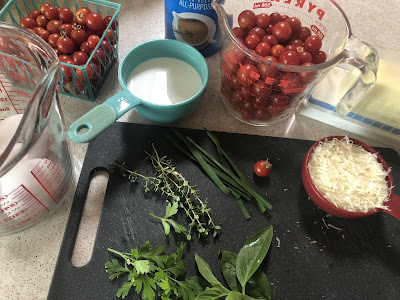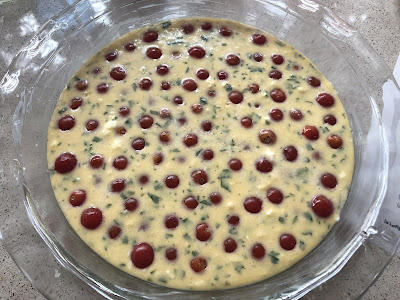
Recipe: Classic French dish gets a veggie makeover

Cherry tomatoes peek through the herbs sprinkled over this savory clafoutis.
(Photos: Kathy Morrison)
|
Gardening is full of surprises. This year one of mine came from the vigorous plant that I thought would give me ping-pong ball-size cherry tomatoes. Instead, they're the size of large peas, or maybe small marbles. And the plant is huge, taller than me, so there are tons of them.
Well, they're cute, but too small for a BLT, that's for sure.
So what to do with this wealth of tiny tomatoes? I was inspired by the very word "cherry." Sweet cherries are great in the French dessert called clafoutis. How about a savory clafoutis featuring this micro crop?
As it turns out, a savory clafoutis is a great brunch dish or appetizer that holds beautifully at room temperature. Not weepy, like a quiche can be, or eggy like a frittata. I used plenty of herbs and just a bit of cheese, but feel free to add more on top if you like.

Herbs and cheese go into the clafoutis along with tomatoes,
milk, flour and eggs.
|
Savory cherry tomato clafoutis
Serves 6
Ingredients:
1/2 cup half-and-half or whole milk
1/2 cup plus 2 tablespoons grated Parmesan cheese, divided
2 tablespoons grated mozzarella cheese (or fontina, Gruyere or cheddar)
3 tablespoons chopped mixed herbs such as parsley, basil, chives and thyme, divided
2-1/2 tablespoons butter, melted, plus more for greasing the pan
3/4 teaspoon kosher salt
Fresh grated black pepper, to taste
4 large eggs, room temperature
1/4 cup all-purpose flour (Wondra if you have it; it blends well)
About 2 cups small cherry tomatoes, stemmed

|
Instructions:
Heat the oven to 400 degrees. Butter a 9-1/2-inch or 10-inch pie plate or baking dish. Whisk together in a large bowl the milk, 1/2 cup plus 1 tablespoon Parmesan, the mozzarella (or substitute), 2 tablespoons of the herbs, the melted butter, salt, pepper and the eggs.
Then whisk in the flour; it's OK if the mixture is a bit lumpy.
Pour the batter into the prepared pan. Gently sprinkle the tomatoes over the batter so they're evenly distributed. Then sprinkle the remaining 1 tablespoon Parmesan over the top. (Add more cheese of your choice here if you really like cheese and tomatoes.)
Bake for 20 minutes, or when the edges are golden brown and the center is set. Remove from the oven to cool and sprinkle the remaining herbs over the top.
Serve warm or at room temperature.
Comments
0 comments have been posted.Sacramento Digs Gardening to your inbox.
Sites We Like
Garden Checklist for week of April 21
This week there’s plenty to keep gardeners busy. With no rain in the immediate forecast, remember to irrigate any new transplants.
* Weed, weed, weed! Get them before they flower and go to seed.
* April is the last chance to plant citrus trees such as dwarf orange, lemon and kumquat. These trees also look good in landscaping and provide fresh fruit in winter.
* Smell orange blossoms? Feed citrus trees with a low dose of balanced fertilizer (such as 10-10-10) during bloom to help set fruit. Keep an eye out for ants.
* Apply slow-release fertilizer to the lawn.
* Thoroughly clean debris from the bottom of outdoor ponds or fountains.
* Spring brings a flush of rapid growth, and that means your garden is really hungry. Feed shrubs and trees with a slow-release fertilizer. Or mulch with a 1-inch layer of compost.
* Azaleas and camellias looking a little yellow? If leaves are turning yellow between the veins, give them a boost with chelated iron.
* Trim dead flowers but not leaves from spring-flowering bulbs such as daffodils and tulips. Those leaves gather energy to create next year's flowers. Also, give the bulbs a fertilizer boost after bloom.
* Pinch chrysanthemums back to 12 inches for fall flowers. Cut old stems to the ground.
* Mulch around plants to conserve moisture and control weeds.
* From seed, plant beans, beets, cantaloupes, carrots, corn, cucumbers, melons, radishes and squash.
* Plant onion sets.
* In the flower garden, plant seeds for asters, cosmos, celosia, marigolds, salvia, sunflowers and zinnias.
* Transplant petunias, zinnias, geraniums and other summer bloomers.
* Plant perennials and dahlia tubers for summer bloom.
* Mid to late April is about the last chance to plant summer bulbs, such as gladiolus and tuberous begonias.
* Transplant lettuce seedlings. Choose varieties that mature quickly such as loose leaf.